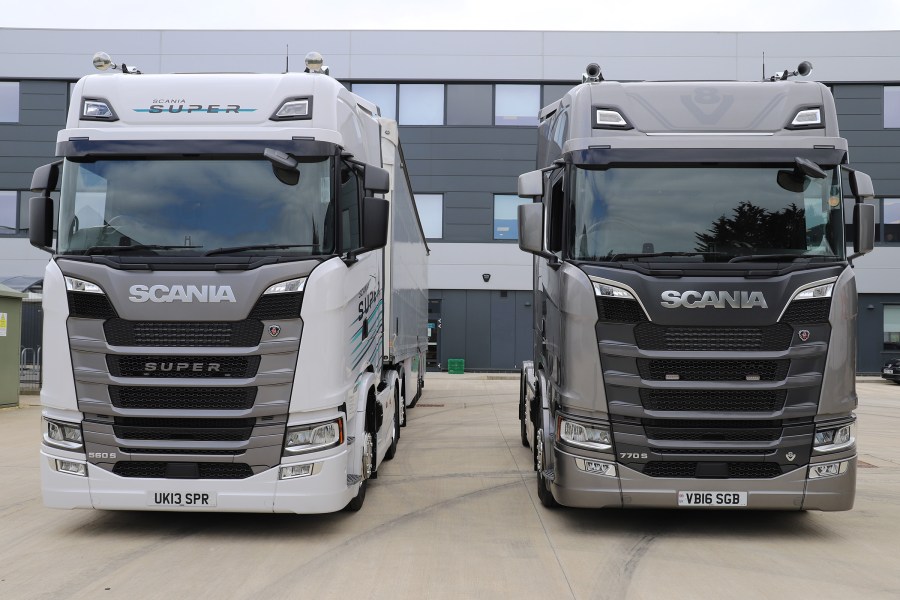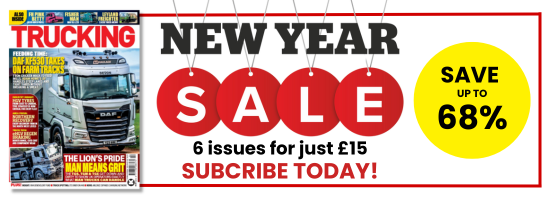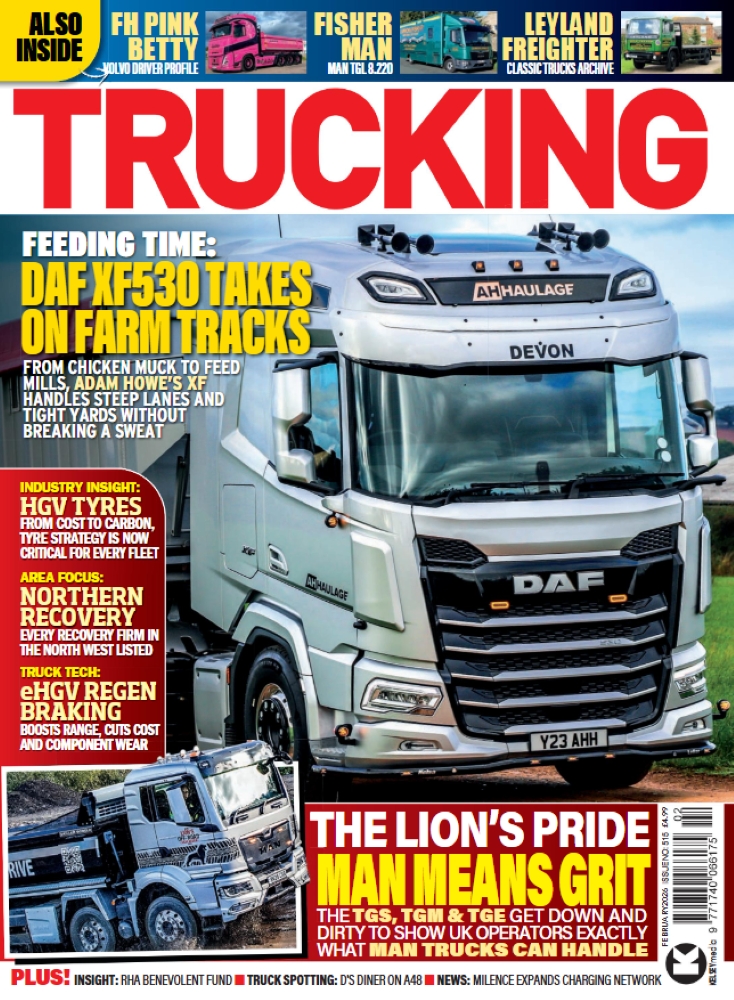Scania’s iconic V8 has been an aspirational truck for decades, and they have a lot going for them. But the straight six has always been a good truck and recently just got even better. But which is the best – the 560S Super or the V8 770S. We took both out to compare them
Scanias sell. They sell well in all sectors above 18 tonnes, and while they may not be the market leader, and despite being a premium brand, you can’t move on the road for the sight of Scanias.
Everything from a humble P220 rigid right up to a V8 770S tractor unit, there is a mass of different Scania models. And that is no surprise, given there are five basic different cab sizes, not to mention a vast array of day, sleeper, high and even flat roofs. In fact the only thing you can’t get from Södertälje is a bonneted cab.
There is every axle arrangement you could wish for in 2, 3, and 4-axle combinations, and pretty much all can be offered with one of the four engine sizes, 7-, 9-, 12.7 and 16.4-litre – only the latter is limited in what cabs can sit above it. There are off-road XT versions of all those chassis, even the low-entry L series models! In short, there is a Scania for every job imaginable. Its modular approach makes it so versatile. If it can build it, it will.
But one Scania stands – literally – head and shoulders above them all – the V8. Well, to many, that is. Certainly to drivers. Operators – and certainly accountants – may beg to differ!
The Scania V8 has been the most aspirational truck for many drivers for decades. Not all of course, but for many. What’s the phrase? “You’re never late in a V8!” (a statement coined before the M25 was opened!)
And as it was 20, 30, 40 years ago, for small fleets and owner drivers, getting a Scania V8 in your fleet symbolised that you’d ‘made it’. Scania only has to launch a limited edition of its V8, which will be sold out within hours. And they always hold their value. In fact, in recent times, you hear of people selling second-hand V8s for as much as they were when they bought them new… four years earlier! That might be a rare situation that some will have you believe, but second hand V8 prices still beggar belief at times.
But do you actually need a V8 beyond the prestige? A V8 is a bigger and heavier engine, and it tends to consume more diesel. And who actually needs 590, 660, or 770hp for 44-tonne work?
Surely the six-cylinder straight six is a better bet? Recently, the DC13 Scania engine was replaced by an all-new 12.7-litre straight six. Scania was claiming improved fuel consumption of “at least 8%”. At the time, I thought it was being incredibly brave, or bold, in saying “at least” and not “up to”. But my initial drives have proved that Scania was right to go so bold. When I drove the 460R – a fleet spec motor – on a couple of days work it smashed the fuel returns out of the park like Ben Stokes on an Aussie-bashing mission.
As I pointed out, while the 460R is probably theif you want to make the most money, there is no escaping the fact that some hauliers want or need the bigger S cab and might want a bit more oomph under said cab, and even a 460S might not quite do just that. But even here, Scania has two other higher outputs of the new engine—at 500 and 560hp—so suddenly, Scania to have you have more choice.
The 560hp version replaces the 540hp of the previous straight six. When Scania launched the New Gen models in 2016, the straight six was initially only available at 370, 410, 450 and 500hp, but the 540hp option was added to the range a couple of years later. My first drive of this was impressive – loaded at 50 tonnes in Norway – and I’ve argued ever since then that it was a very good bet for a flagship. It was also 20hp more than the entry level V8; the new 560S is now 30hp more than the current lowest-powered V8, the 530.
As regards the New Gen V8s, the initial launch models were 520, 580 and 730hp then the 650 was added a couple of years later and widely regarded by many as the best of the bunch if you wanted eight cylinders. Then in 2020 the V8 was tweaked – and all four models went up a few horsepower – to 530, 590, 660 and the new king – 770 – the latter now the most powerful production series truck in Europe. It sold as it was a Scania, it was a V8 and it was the biggest on offer.
It is worth reminding readers you can have any V8 with either an R or S cab while the new Super powertrain is available on P, G, R and S cabs except there being no 560P option. The badges also now have the cab designation after the power.
All can be 4×2, 6×2 midlift, 6×2 small midlift or 6×2 tag axle (and 6x4s or some as 8x4s for heavy haulage). Rigids are also available as 4×2, 6×2, 6×4, 8×2 and 8×4 sets ups, including Tridems.
So, in early June, I headed to Milton Keynes to compare the two largest Scania engines’ outputs to see which was the best—the highest output of the straight six—a 560S—and the meatiest V8 – a 770S. Both had the biggest cab andough the 560S was a tag axle and the 770S a midlife. But other than that, they were pretty much every inch a standard 44- were 6x2s, althtonne tractor unit.
Both have conventional mirrors – Scania has tested digital mirrors – in fact they were shown off to the press at the launch of the new Super Powertrain back in November 2021, yet we’ve heard nothing about them since. Scania was honest that they were not ready to bring to market, but I was kind of hoping they may have been an option by now!
My plan was to take them on an identical route that was mostly motorway with a bit of rural and town driving and on the day I thankfully didn’t have to deviate from the route.
The route was from Scania’s Milton Keynes base, from where I headed to the M1 at Junction 14 to drive north, then on to the M45, which morphs into the A45, were I came off and headed via some very twisty single carriageway roads to Princethorpe, then up to Ryton-on-Dunsmore and back onto the A45 to rejoin the M45 then the M1 and back home.
First up was the 770S…
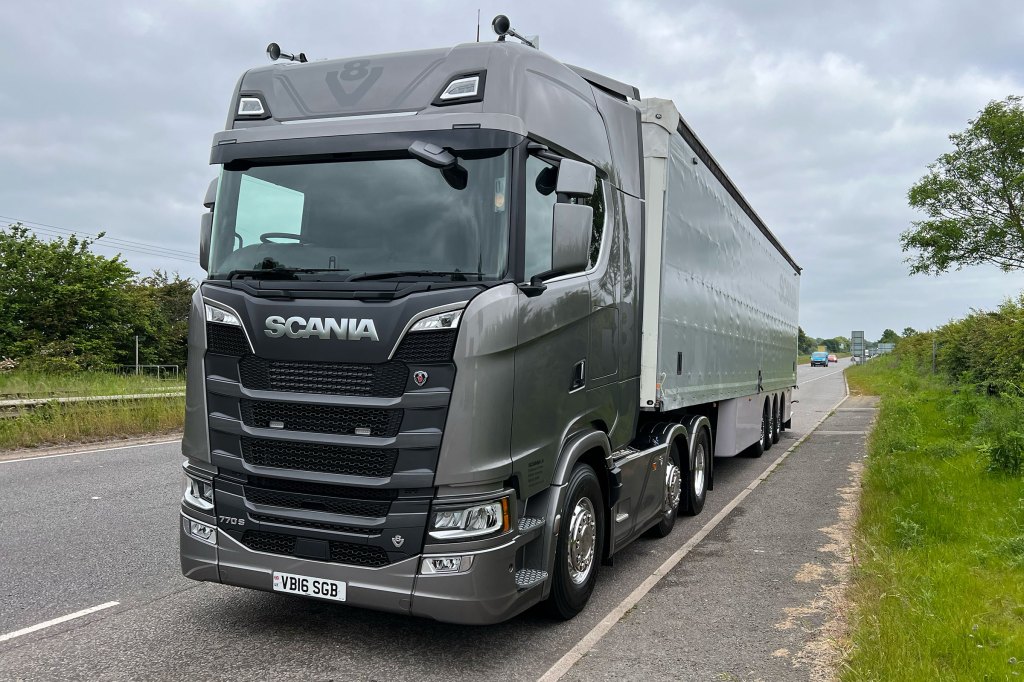
The 770S
As mentioned, the 770S was a midlift 6×2 with the Highline S cab, the biggest cab Scania offers and very popular with long-haul operators.
The powertrain was the DC16 16.4-litre V8 coupled to the GRSO926R Opticruise gearbox and the R780 rear axle with a ratio of 1:3.08. the R4100D retarder was also fitted.
The engine is rated at 770hp and 3,700 Nm of torque which, let’s face it, is way more than you’ll ever need for 44 tonnes, although as has been pointed out there is talk of possible weight limit increases to 48 to even 52 tonnes. That said, you probably wouldn’t need that level of power and torque for either of those weights either!
As I have to come to expect from any New Gen Scania, there is little to fault it on the driving experience; they are surefooted, handle well, don’t rock about, and there are no unsavoury noises.
Pulling away pretty much fully loaded with 770hp available is a breeze, and the only hindrance is other traffic. It begs the question of how good these trucks could be if there were no other road users!
Once on the M1, past the roadworks, with traffic flowing, it was a case of usingcruise control and sitting back and enjoying the ride. It’s so easy to see why any driver would have little challenge coming into work if this was their daily steed. There are no rattles or draughts, the adaptative and the ambience in the S cab is understandably one of the best in the business.
The truck also had Cruise Control with Active Prediction (CCAP) fitted. CCAP is now included in all Scanias with the G25 and G33 gearboxes and can be retrofitted on trucks with the super-based powertrain. It works by vastly increasing the computing capacity, and using smarter algorithms and optimised use of map data, to offer an additional fuel savings of up to 2% on undulated roads while typically still maintaining the same average speed.
Scania says drivers using CCAP should experience even better flow and the truck will eco roll for longer stretches. It will ‘see’ the topography for the road ahead and thus select the best gear and put the vehicle in to eco roll where it is best to do so, thus reducing the fuel consumption.
The axle set-up was slightly unusual with a 9,000kg front axle and 10,000kg drive axle, and the midlift only rated at 6,000kg, and the wheelbase was 4,050mm, making it marginally longer than some equivalent midlift trucks, which tend to favour 3.9m wheelbases.
Being a top of the range V8, the interior seats were the predictable black leather – with the famous V8 logo embossed in the headrests. The seats had armrests. It is worth mentioning that Scania is close to introducing a new digital dashboard and I hope digital mirrors are not too far behind it
This truck oozes quality, that is for sure. With the new CS23 extended cab now being prepared for the market, Scania is making sure it doesn’t lose too much ground in the premium market to DAF and others.
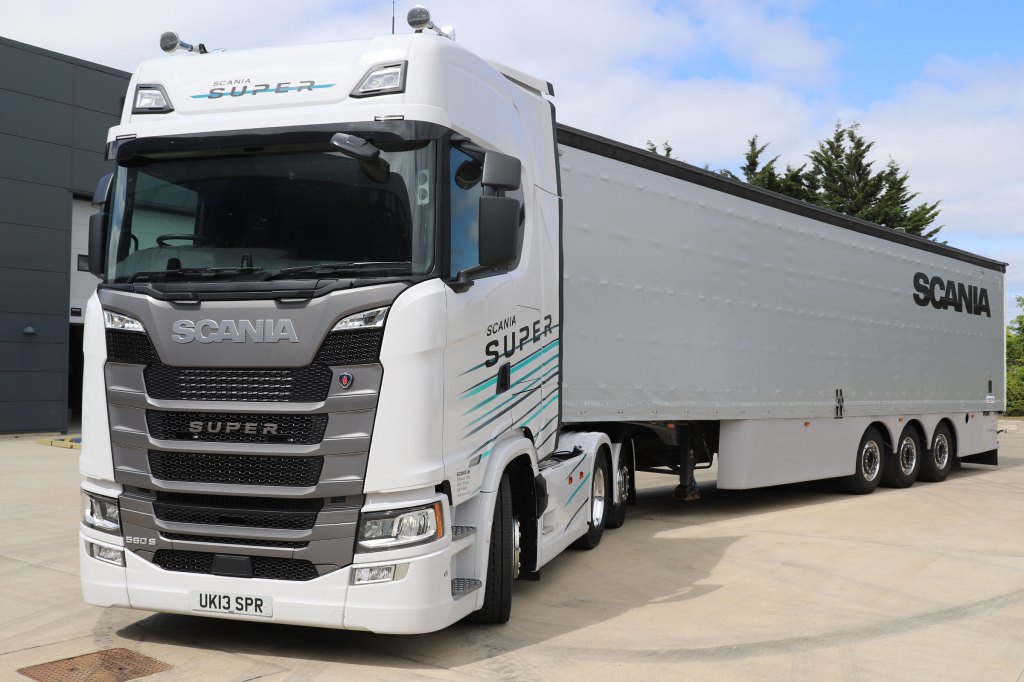
The 560S
As mentioned, the 560S set up a tag axle, an arrangement popular with some operators – especially those north of the Pennines – but tags do not sell as much as a midlift.
Tags have advantages in gaining traction in hilly, off-road situations, making them popular with timber and quarry operators, and have a shorter wheelbase making them more manoeuvrable.
They are fractionally more expensive to buy, although tend to keep that value in their residuals. But they can bob about a bit on the road, even more so if the tag axle is lifted which is usually the case when unloaded, to save tyre wear.
I admit they look better, but – even for as Scania – you shouldn’t spec your truck on looks, you need to spec it for the job in hand. So with a standard tautliner trailer, these days, most operators would probably prefer a midlift and on the road, the midlift certainly handles a lot much more comfortably. But, that said, not enough to make me get out thinking ‘I never want to drive a tag axle again!’
The 560S has the DC13 straight six 12.74-litre engine, and while it produced ‘just’ 560hp, its torque rating of 2,650Nm is more than enough for standard 44 tonne work.
The truck has Scania’s relatively new G33CM Opticruise Gearbox and the R780 rear axle at a ratio of 1:2.59. The R4700D retarder was also fitted. The engine brake on both trucks was superb, and much improved.
The axle set up was a more conventional 8,000kg front axle, 11,500kg drive axle and the rear tag was rated at 7,500kg and the wheelbase was 2,950mm.
Being a press truck, then no expense has been spared and the 560S also had leather seats. In fact apart from the logos, there’s not a lot of difference compared with the V8 in terms of the interior. The 560S had the electronic parking brake while the 770S has the traditional handle. As regular readers will possibly know, I prefer the latter, as I just find it more reassuring. That said, with the former, it means when you are parked at a junction, you can just accelerate away and the parking brake comes off and away you go, so it does save a few seconds here and there. The hill hold function is also very good on the Scanias.
The engine brake on Scanias is better these days while there is also less tendency for them to run away when going downhill even when on cruise control which had been an issue with some of the earlier New Gen models. The 560S also had CCAP.
Both trucks were running on full air suspension throughout, something you really start to appreciate on the shocking state of the UK’s road surfaces. They also had 315/70 R22.5 tyres throughout with the exception of the 770S which has the front axle on 385/65 R22.5s.
Which is best?
I’m probably a bit more conservative, or even realistic, that some others when it comes to spec’ing a Scania, but I have to say, and let’s not beat about the bush here, the 560S is head and shoulders the best truck out of these two and therefore the best here for anybody engaged in general haulage.
Journey times, were virtually identical, in fact over the two hour trip, the 770S was just two minutes quicker round. So over a day, it might get you eight to ten minutes further up the road. I’d say that is borderline irrelevant on pretty much any operation in the UK these days.
Even on, say, my oft-quoted Aberdeen to Milan run, then it going to save you an hour or two tops. Remember, both can only do 56mph and getting up to that speed is impressive in both trucks. The 560S is certainly no slowcoach. You might get a better saving on a 770S over, say, a 460R when both are fully loaded, but again, I doubt it would really make too much difference.
But where the straight six truly kicked butt was on its fuel. It was showing a fuel consumption of about 2mpg better than its V8 sibling – on such a short route as well. I’ve said it before, but the new Super powertrain is the best that Scania has ever produced. And given my previous experience with the 460R it’s hard to dispute that.
But before I get hate mail from V8 aficionados, the 770S does have a role – enough people buy then. And I have no doubt they’d rush to buy an 800S, an 850S, even a 1000S if Scania were ever to produce such a truck! The 770S is certainly a good fit for heavy haulage, and also for some operators enduring day in, day, lengthy stretches of especially hilly terrain and they might find it what they need.
There is many a haulier in the Highlands who specs a V8 for just that reason. The 770S might be extremely expensive to buy in the first place but you’ll never have a problem selling one, and wouldn’t even need to spend anything to advertise it!
It also has a role as a fleet flagship, or a driver reward vehicles for your best and/or longest standing driver(s). Or if you just operate one truck, and do your sums accordingly, then again buying a V8 – or any other high powered flagship – does have its merits.
But I would also suggest that 560 will hold its value exceptionally well and it too, with an S cab, is also a pretty good flagship. Again, you’d have no issue selling one. In short the 560S will be cheaper to buy, lighter, do pretty much any job a 770S can and above all, save you a shed load of cash when filling it up.
I would also say hand on heart its total cost of ownership would be considerably better than its bigger brethren, even with the latter having a better resale price. And being a Scania if looked after, it’ll last you easy for a decade or well over a million clicks, and anything up to twice that. In fact, the only thing that might be against is, will come from legislation.
If I were off to my Scania dealer for a flagship, then I’d be signing up for a straight six Super over a V8 any day of the week. The pure basic economics case weighs so heavily in favour of the 560S over the 770S in pretty much every respect. But having said all that, I do understand why some prefer a 770S, and Scania’s V8s will continue to sell regardless.
Scania 560S
- Design GCW: 44,000kg
- Chassis: 2,950mm wheelbase
- Front axle: 8,000kg capacity.
- Rear axle: 11,500kg (drive) 7,500kg (tag)
- Gearbox: G33CM 12-speed
- Engine: DC13-173 12.74-litre 6-cylinder in line, Euro 6e
- Max power: 560bhp @ 1,400-1,800rpm
- Max torque: 2,800Nm @ 900-1,400rpm
- Cab: S Highline sleeper
We like: 560S
- Fuel economy
- Build quality
- Great cab
- Great TCO business case
We don’t like: 560S
- Ride a bit bouncy
Scania 770S
- Design GCW: 44,000kg
- Chassis: 4,050mm wheelbase
- Front axle: 9,000kg capacity.
- Rear axle: 10,000kg (drive) 6,500kg (midlift)
- Gearbox: GRS0926R 12-speed
- Engine: DC16-123 16.4-litre V8-cylinder, Euro 6e
- Max power: 770bhp @ 1,900rpm
- Max torque: 3,700Nm @ 1,000-1,450rpm
- Cab: S Highline sleeper
We like: 770S
- That badge!
- Residual value
- Excellent handling
- Cab interior
We don’t like: 770S
- A bit too heavy
- Expensive to buy

